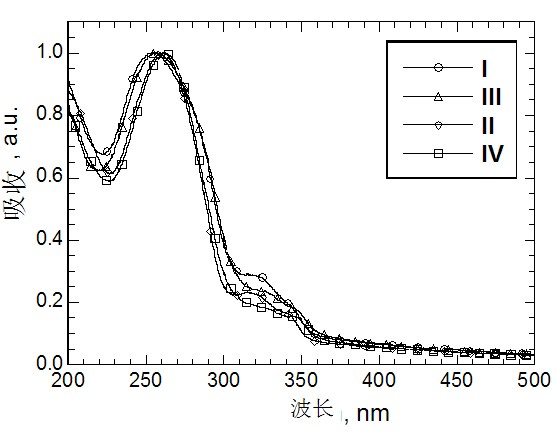Heterocompound organic material containing pyridine and metadiazine as well as preparation method and application thereof
An organic material, pyridine technology, applied in the field of organic electroluminescent materials, can solve problems such as increasing electron injection barriers from the cathode to the light-emitting layer, increasing device driving voltage, and complex device structure, so as to suppress energy transfer and reduce driving voltage , The effect of simple device structure
- Summary
- Abstract
- Description
- Claims
- Application Information
AI Technical Summary
Problems solved by technology
Method used
Image
Examples
Embodiment 1
[0033] Example 1: Preparation of 4,6-bis(3,5-bis(3-pyridyl)phenyl)-2-(3-pyridyl)pyrimidine (I)
[0034]
[0035] Step 1: 2-Chloro-4,6-bis(3,5-dichlorophenyl)pyrimidine
[0036] Under a nitrogen atmosphere, add 2,4,6-trichloropyrimidine (5.50g, 30mmol), 3,5 dichlorophenylboronic acid (12.0g, 63mmol), 2M potassium carbonate aqueous solution (60ml) into a 250ml three-necked flask , triphenylphosphorous palladium chloride (0.84g, 1.2mmol) and acetonitrile (150ml), stirred and reacted for 22 hours under heating at 50 degrees Celsius. After the reaction was naturally cooled, the reaction solution was extracted with chloroform, washed three times with saturated brine, and the obtained organic layer was dried over anhydrous magnesium sulfate. Filter with suction, and remove the solvent in the resulting filtrate under reduced pressure. Separation with a chromatographic column, the mobile phase used is chloroform / n-hexane=2:1. After being spin-dried, vacuum-dried to obtain 11.2 g ...
Embodiment 2
[0045] Example 2: Preparation of 4,6-bis(3,5-bis(4-pyridyl)phenyl)-2-(3-pyridyl)pyrimidine (II)
[0046]
[0047] The first two steps of the present embodiment are the same as the first two steps of the first embodiment.
[0048] Step 3: 4,6-bis(3,5-bis(4-pyridyl)phenyl)-2-(3-pyridyl)pyrimidine
[0049] Under a nitrogen atmosphere, 4,6-bis(3,5-dichlorophenyl)-2-(3-pyridyl)pyrimidine (0.80g, 1.8mmol), 4-pyridineboronic acid were added to a 250ml three-necked flask Ester (4.41g, 2.15mmol), aqueous potassium phosphate (2.58g, 30ml), tris(dibenzylideneacetone)dipalladium (0.20g, 0.21mmol), tricyclohexylphosphine (0.15g, 0.52mmol) and 1 , 4-dioxane (100ml), stirred and reacted under reflux for 24 hours. After the reaction was naturally cooled, the reaction solution was extracted with chloroform, washed three times with saturated brine, and the obtained organic layer was dried over anhydrous magnesium sulfate. Filter with suction, and remove the solvent in the resulting filtra...
Embodiment 3
[0052] Example 3: Preparation of 4,6-bis(3,5-bis(3-pyridyl)phenyl)-2-(3-(3-pyridyl)phenyl)pyrimidine (III)
[0053]
[0054] The first step of the present embodiment is the same as that of the first embodiment.
[0055] Step 2: 4,6-bis(3,5-dichlorophenyl)-2-(3-(3-pyridyl)phenyl)pyrimidine
[0056] Under a nitrogen atmosphere, 2-chloro-4,6-bis(3,5-dichlorophenyl)pyrimidine (4.04g, 10mmol), 3-(3-pyridyl)phenylboronic acid were added to a 250ml three-necked flask Ester (3.09g, 11mmol), 2M potassium carbonate aqueous solution (50ml), triphenylphosphorous palladium chloride (0.14g, 0.2mmol) and 1,4-dioxane (120ml), stirred reaction under heating reflux condition 18 Hour. After the reaction was naturally cooled, the reaction solution was extracted with chloroform, washed three times with saturated brine, and the obtained organic layer was dried over anhydrous magnesium sulfate. Filter with suction, and remove the solvent in the resulting filtrate under reduced pressure. Separ...
PUM
 Login to View More
Login to View More Abstract
Description
Claims
Application Information
 Login to View More
Login to View More - Generate Ideas
- Intellectual Property
- Life Sciences
- Materials
- Tech Scout
- Unparalleled Data Quality
- Higher Quality Content
- 60% Fewer Hallucinations
Browse by: Latest US Patents, China's latest patents, Technical Efficacy Thesaurus, Application Domain, Technology Topic, Popular Technical Reports.
© 2025 PatSnap. All rights reserved.Legal|Privacy policy|Modern Slavery Act Transparency Statement|Sitemap|About US| Contact US: help@patsnap.com



